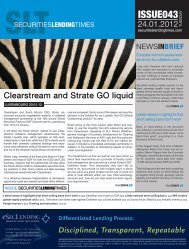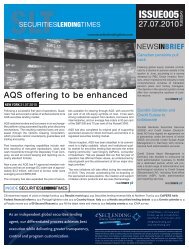Collateral Management - Securities Lending Times
Collateral Management - Securities Lending Times
Collateral Management - Securities Lending Times
You also want an ePaper? Increase the reach of your titles
YUMPU automatically turns print PDFs into web optimized ePapers that Google loves.
whether these systems will continue to functionproperly during the next few years according tothe requirements. The other options are to buildan entirely new system or to buy one.Vuyst: Once this analysis is made, we move tothe third step, which is testing, application development,documentation, and making sure thateverything has been executed and implementedaccording to the client requirements. The fourthand final step is support and monitoring, from botha functional and a technical angle. This can all bedone in cooperation with the internal IT departmentand/or other vendors. Alongside this, a keycomponent of each project is to decide with the clientwhat the optimal ratio between onsite and offshorerecourses is in relation to quality and cost.Baauw: Those are the four steps that we offerwhen going into a business, but some clients do notrequire us to carry out all of them. Some clients willneed just consultancy services, while others wantus to analyse, implement and execute, and thencarry out testing and so on. Of course, a specificcombination of these steps is always possible, butwhat we also heard a lot when we were speakingwith people at the International <strong>Securities</strong> <strong>Lending</strong>Association conference in Madrid was that optingfor a combination of steps could cause problems.Vuyst: The main problem that could arise is theinterpretation of documentation that is createdby another participant in the value chain and thiscould result in a lack of clarity and disconnect.But of course we offer and do all four disciplinesseparately or in any possible combination.How do securities finance businessestend to operate—do they go for allfour steps or a combination?Baauw: Most of the time you see a combination,but from time to time you see the entirechain. You see this, for example, in the set upof a new desk or when the plan is to launch anew product. But there is not really one answerto this question because every bank and tradingdesk has a different structure, scale, number ofentities, complexity of products, and so on.Vuyst: We have seen companies with reallysophisticated IT environments, which only lookat step four, so we monitor and maintain theirlegacy systems offshore. Others could be a startup, in a growing phase or undergoing a re-organisation,so they need all kinds of advice andanalysis on all kind of topics.Baauw: On the other hand, sometimes you seetrading desks or investment banks thinking thatthey require a different system to adapt to upcomingchanges so they can grow to the nextlevel, but they do not really need it. They onlywant to buy and bring in a brand new systembecause they have worked with their existingsystem for so long and they think the grasslooks greener elsewhere. When we come in,we can look at these things with a fresh pair ofindependent eyes and advise accordingly. If wedo not need think that the systems or processesneed to change, then this is what we will advisebecause we always aim to have a transparentrelationship with our clients for the long run.How are securities finance tradingdesks doing at the moment?Baauw: Everybody knows that the golden yearsare behind us and I doubt if they will come back inthe next coming years. The securities finance tradingdesks are trying to keep up flow, which is certainlynot always easy, and they are also dependentsometimes on external factors. The larger firms willalways get some flow and most of the time they willtry to spread it to the larger firms on the other side.But the smaller or medium-size trading desks havethe advantage that they can quickly change to a differentstrategy or adapt to a new situation. This isalso what we sometimes see on the IT side. If thereis a large bank with multiple locations and with 10different systems, it is not always easy to changesomething. If you have one desk with four equityfinance traders, two people on the collateral desk,one repo trader and a couple of people on the operations,it is easier to change the IT environment.Vuyst: The trading desks are always looking fornew opportunities, but that is not easy to findthese days. On the other hand, the result of thisis that the front office is not only becoming morecost aware, but is also becoming more valueaware. They are assessing whether the environmentsand processes in which they operateare still optimal for them. They are very awareof other things—not just trades and new opportunitiesand so on—they are also looking at theoperational and technical sides.Baauw: The process that Ray Vuyst described hasof course had the same impact on profit and loss.Another aspect, which is also changed, is the clientside. In the past, it was easier to grow profit on theclient side. Finding new clients was just easier todo 10 years ago. It was possible to visit all kindsof countries and find smaller, new players thatyou had never traded with before. Nowadays, ifyou—under the existing circumstances—try to dothe same you will experience more obstacles fromthe enabling units that are more careful about risk,compliance and procedures.Vuyst: One of the other major shifts in interestof the trading desks for the last couple of yearsis on the collateral side. The pricing of assetclasses is done in detail these days and this canmake or break your trade. Next to this, the globalinventory management of collateral for an entirecompany is extremely important across alldisciplines. To have this entirely automated andwith real time reporting and dashboards is oneof the biggest challenges for all stakeholders.What are you charged with achievingat Synechron?Baauw: We are focusing on securities financeworldwide with a strong focus on business consultancyand IT solutions and services. But in Europe,we are also trying to expand in other areasof the capital markets, such as commodities, via31SBLTechnologythe existing contacts that we have built up in thesecurities finance market during the last decade.Most of Synechron’s clients have stayed withthe company for years and they continue to doso. Without achieving customer satisfaction andcreating that staying power, a company can havea very bumpy clientele where clients come andgo, which means that there is no pulling powerbehind the brand. Synechron is not in this situation—whenit attracts clients, they stick around.Vuyst: This is what we want to replicate andbuild on in securities finance. We want to developan even better brand and also becomewell known in our market. We can do this onthree ways: (i) expand the work that we do withcurrent clients, not only in securities finance butin different areas that the client operates in aswell; (ii) attract new clients, because there is stilla lot of potential clients that do not know Synechron,especially in this area; and (iii) set upand expand the business consultancy practice.Although we are a fast growing company, our goalis not to be the biggest in the market, but we tryto be the best in the market. This way we automaticallygain good and solid client references byfocusing on client satisfaction. This is a core valueof the company. In securities finance, we will getcustomer satisfaction through excellent executionand being able to work in an agile way with a clientand other parties that are involved. SLTRaymond VuystManaging director—continental Europe businessSynechronSander BaauwManaging director—continental Europe businessSynechronwww.securitieslendingtimes.com












